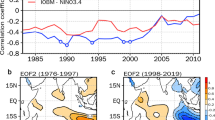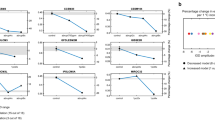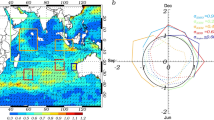Abstract
Natural modes of variability centred in the tropics, such as the El Niño/Southern Oscillation and the Indian Ocean Dipole, are a significant source of interannual climate variability across the globe. Future climate warming could alter these modes of variability. For example, with the warming projected for the end of the twenty-first century, the mean climate of the tropical Indian Ocean is expected to change considerably. These changes have the potential to affect the Indian Ocean Dipole, currently characterized by an alternation of anomalous cooling in the eastern tropical Indian Ocean and warming in the west in a positive dipole event, and the reverse pattern for negative events. The amplitude of positive events is generally greater than that of negative events. Mean climate warming in austral spring is expected to lead to stronger easterly winds just south of the Equator, faster warming of sea surface temperatures in the western Indian Ocean compared with the eastern basin, and a shoaling equatorial thermocline. The mean climate conditions that result from these changes more closely resemble a positive dipole state. However, defined relative to the mean state at any given time, the overall frequency of events is not projected to change — but we expect a reduction in the difference in amplitude between positive and negative dipole events.
This is a preview of subscription content, access via your institution
Access options
Subscribe to this journal
Receive 12 print issues and online access
$259.00 per year
only $21.58 per issue
Buy this article
- Purchase on Springer Link
- Instant access to full article PDF
Prices may be subject to local taxes which are calculated during checkout




Similar content being viewed by others
References
Le Treut, H. et al. in Climate Change 2007: The Physical Science Basis (eds. Solomon, S. et al.) 19–20 (Cambridge University Press, 2007).
Gleckler, P. J. et al. Human-induced global ocean warming on multidecadal timescales. Nature Clim. Change 2, 524–529 (2012).
Alory, G., Wijffels, S. & Meyers, G. Observed temperature trends in the Indian Ocean over 1960–1999 and associated mechanisms. Geophys. Res. Lett. 34, L02606 (2007).
Saji, N. H., Goswami, B. N., Vinayachandran, P. N. & Yamagata, T. A dipole in the tropical Indian Ocean. Nature 401, 360–363 (1999).
Webster, P. J., Moore, A. M., Loschnigg, J. P. & Leben, R. R. Coupled oceanic-atmospheric dynamics in the Indian Ocean during 1997–98. Nature 401, 356–360 (1999).
Yu, L. & Rienecker, M. M. Mechanisms for the Indian Ocean warming during the 1997–98 El Niño. Geophys. Res. Lett. 26, 735–738 (1999).
Murtugudde, R., McCreary, J. P. & Busalacchi, A. J. Oceanic processes associated with anomalous events in the Indian Ocean with relevance to 1997–1998 J. Geophys. Res. 105, 3295–3306 (2000).
Cai, W., Cowan, T. & Sullivan, A. Recent unprecedented skewness towards positive Indian Ocean Dipole occurrences and its impact on Australian rainfall. Geophys. Res. Lett. 36, L11705 (2009).
Ihara, C., Kushnir, Y. & Cane, M. A. Warming trend of the Indian Ocean SST and Indian Ocean Dipole from 1880 to 2004. J. Clim. 21, 2035–2046 (2008).
Abram, N. J., Gagan, M. K., Cole, J. E., Hantoro, W. S. & Mudelsee, M. Recent intensification of tropical climate variability in the Indian Ocean. Nature Geosci. 1, 849–853 (2008).
Kripalani, R. H., Oh, J. H. & Chaudhari, H. S. Delayed influence of the Indian Ocean Dipole mode on the East Asia–West Pacific monsoon: possible mechanism. Int. J. Climatol. 30, 197–209 (2010).
Ashok, K., Guan, Z. & Yamagata, T. Influence of the Indian Ocean Dipole on the Australian winter rainfall. Geophys. Res. Lett. 30, L1821 (2003).
Meyers, G. A., McIntosh, P. C., Pigot, L. & Pook, M. J. The years of El Niño, La Niña, and interactions with the tropical Indian Ocean. J. Clim. 20, 2872–2880 (2007).
Ummenhofer, C. C. et al. What causes southeast Australia's worst droughts? Geophys. Res. Lett. 36, L04706 (2009).
Zubair, L., Rao, S. A. & Yamagata, T. Modulation of Sri Lankan Maha rainfall by the Indian Ocean dipole. Geophys. Res. Lett. 30, 1063 (2003).
Behera, S. K. et al. Paramount impact of the Indian Ocean Dipole on the East African short rains: A CGCM study. J. Clim. 18, 4514–4530 (2005).
Black, E., Slingo, J. & Sperber, K. R. An observational study of the relationship between excessively strong short rains in coastal East Africa and Indian Ocean SST. Mon. Weather Rev. 131, 74–94 (2003).
Ashok, K., Guan, Z. & Yamagata, T. Impact of the Indian Ocean dipole on the relationship between the Indian monsoon rainfall and ENSO. Geophys. Res. Lett. 28, 4499–4502 (2001).
Cai, W., Cowan, T. & Raupach, M. Positive Indian Ocean Dipole events precondition southeast Australia bushfires. Geophy. Res. Lett. 36, L19710 (2009).
Abram, N. J., Gagan, M. K., McCulloch, M. T., Chappell, J. & Hantoro, W. S. Coral reef death during the 1997 Indian Ocean Dipole linked to Indonesian wildfires. Science 301, 952–955 (2003).
Hashizume, M., Chaves, L. F. & Minakawa, N. Indian Ocean Dipole drives malaria resurgence in East African highlands. Sci. Rep. 2, 269 (2012).
Tokinaga, H. & Tanimoto, Y. Seasonal transition of SST anomalies in the tropical Indian Ocean during El Niño and Indian Ocean Dipole years. J. Meteorol. Soc. Japan 82, 1007–1018 (2004).
Fischer, A., Terray, P., Guilyardi, E., Gualdi, S. & Delecluse, P. Two independent triggers for the Indian Ocean Dipole/Zonal Mode in a coupled GCM. J. Clim. 18, 3428–3449 (2005).
Abram, N. J. et al. Seasonal characteristics of the Indian Ocean Dipole during the Holocene epoch. Nature 445, 299–302 (2007).
Annamalai, H., Xie, S. -P., McCreary, J. P. & Murtugudde, R. Impact of Indian Ocean sea surface temperature on developing El Niño. J. Clim. 18, 302–319 (2005).
Yuan, D. et al. Forcing of the Indian Ocean Dipole on the interannual variations of the tropical Pacific Ocean: roles of the Indonesian Throughflow. J. Clim, 24, 3593–3608 (2011).
Luo, J. J. et al. Interaction between El Niño and Extreme Indian Ocean Dipole. J. Clim. 23, 726–742.
Izumo T. et al. Influence of the state of the Indian Ocean Dipole on the following year's El Niño. Nature Geosci. 3, 168–172 (2010).
Saji, N. H. & Yamagata, T. Possible impacts of Indian Ocean Dipole mode events on global climate. Clim. Res. 25, 151–169 (2003).
Cai, W., van Rensch, P., Cowan, T. & Hendon, H. H. Teleconnection pathways of ENSO and the IOD and the mechanisms for impacts on Australian rainfall. J. Clim. 24, 3910–3923 (2011).
Bjerknes, J. Atmospheric teleconnections from the equatorial Pacific. Mon. Weather Rev. 97, 163–172 (1969).
Reverdin, G., Cadel, D. & Gutzler, D. Interannual displacements of convection and surface circulation over the equatorial Indian Ocean. Q. J. R. Meteorol. Soc. 112, 43–67 (1986).
Hastenrath, S., Nicklis, A. & Greischar, L. Atmospheric-hydrospheric mechanisms of climate anomalies in the western equatorial Indian Ocean. J. Geophys. Res. 98, 20219–20235 (1993).
Udea, H. & Matsumoto, J. A. Possible triggering process of east–west asymmetric anomalies over the Indian Ocean in relation to 1997/1998 El Niño. J. Meteor. Soc. Japan 78, 803–818 (2000).
Xie, S.-P., Annamalai, H., Schott, F. & McCreary, J. P. Jr. Origin and predictability of South Indian Ocean climate variability. J. Clim. 15(8), 864–874 (2002).
Annamalai, H., Murtugudde, R. Wang, B. Potemra, J. & Xie, S-P. Coupled dynamics in the Indian Ocean: spring initiation of the zonal mode. Deep Sea Res. II 50, 2305–2330 (2003).
Murtugudde, R. & Busalacchi, A. J. Interannual variability of the dynamics and thermodynamics, and mixed layer processes in the Indian Ocean. J. Clim. 12, 2300–2326 (1999).
Li, T., Zhang, Y. S., Chang, C-P., Lu, E. & Wang, D. Relative role of dynamic and thermodynamic processes in the development of the Indian Ocean dipole: An OGCM diagnosis. Geophys. Res. Lett. 29, 2110 (2002).
Li, T., Wang, B., Chang, C-P. & Zang, Y. A theory for the Indian Ocean dipole–zonal mode. J. Atmos. Sci. 60, 2119–2135 (2003).
Shinoda, T., Alexander, M. A. & Hendon, H. H. Remote response of the Indian Ocean to interannual SST variations in the tropical Pacific. J. Clim. 17, 362–372 (2004).
Hong, C. C., Li, T., Lin, H. & Kug, J. S. Asymmetry of the Indian Ocean Dipole. Part I: Observational Analysis. J. Clim. 21, 4834–4848 (2008).
Hong, C. C. & Li, T. Independence of SST skewness from thermocline feedback in the eastern equatorial Indian Ocean. Geophys. Res. Lett. 37, L11702 (2010).
Cai, W. & Qiu, Y. An observation-based assessment of nonlinear feedback processes associated with the Indian Ocean Dipole. J. Clim. 26, 2880–2890 (2013).
Ogata, T., Xie, S.-P., Lan, J. & Zheng, X. Importance of ocean dynamics for the skewness of the Indian Ocean Dipole mode. J. Clim. 26, 2145–2159 (2013).
Iizuka, S., Matsuura, T. & Yamagata, T. The Indian Ocean SST dipole simulated in a coupled general circulation model. Geophys. Res. Lett. 27, 3369–3372 (2000).
Baquero-Bernal, A., Latif, M. & Legutke, S. On dipole-like variability of sea surface temperature in the tropical Indian Ocean. J. Clim. 15, 1358–1368 (2002).
Yu, J.-Y., Mechoso, C. R., McWilliams, J. C. & Arakawa, A. Impacts of the Indian Ocean on the ENSO cycle. Geophys. Res. Lett. 29, 1204 (2002).
Loschnigg, J., Meehl, G. A., Webster, P. J., Arblaster, J. M. & Compo, G. P. The Asian monsoon, the Tropospheric Biennial Oscillation, and the Indian Ocean Zonal Mode in the NCAR CSM. J. Clim. 16, 1617–1642 (2003).
Gualdi, S., Guilyardi, E., Navarra, A., Masina, S. & Delecluse, P. The interannual variability in the tropical Indian Ocean as simulated by a CGCM. Clim. Dyn. 20, 567–582 (2003).
Lau, N-C. & Nath, M. J. Coupled GCM simulation of atmosphere–ocean variability associated with zonally asymmetric SST changes in the tropical Indian Ocean. J. Clim. 17, 245–265 (2004).
Spencer, H., Sutton, R. T., Slingo, J. M., Roberts, M. & Black, E. Indian Ocean climate and dipole variability in Hadley Centre coupled GCMs. J. Clim. 18, 2286–2306 (2005).
Saji, N. H., Xie, S-P. & Yamagata, T. Tropical Indian Ocean variability in the IPCC 20th-century climate simulations. J. Clim. 19, 4397–4417 (2006).
Cai, W., Sullivan, A. & Cowan, T. Interactions of ENSO, the IOD, and the SAM in CMIP3 models. J. Clim. 24, 1688–1704 (2010).
Liu, L., Yu, W. & Li, T. Dynamic and thermodynamic air-sea coupling associated with the Indian Ocean Dipole diagnosed from 23 WCRP CMIP3 models. J. Clim. 24, 4941–4958 (2011).
Zheng, X. T. et al. Indian Ocean Dipole response to global warming in the CMIP5 multimodel ensemble. J. Clim. 26, 6067–6080 (2013).
Meehl, G. et al. The WCRP CMIP3 multimodel Dataset: A New Era in Climate Change Research. Bull. Am. Meteorol. Soc. 88, 1383–1394 (2007).
Taylor, K. E., Stouffer, R. J. & Meehl, G. A. An overview of CMIP5 and the experimental design. Bull. Am. Meteorol. Soc. 93, 485–498 (2012).
Rayner, N. A. et al. Global analyses of sea surface temperature, sea ice, and night marine air temperature since the late nineteenth century. J. Geophys. Res. 108, 4407 (2003).
Ishii, M. & Kimoto, M. Reevaluation of historical ocean heat content variations with time-varying XBT and MBT depth bias corrections. J. Oceanogr. 65, 287–299 (2009).
Smith, T. M. & Reynolds, R. W. Improved extended reconstruction of SST (1854–1997). J. Clim. 17, 2466–2477 (2004).
Alley, R. et al. Climate change 2007: The physical science basis, summary for policymakers (World Meteorol. Org., 2007).
Collins, M. et al. A comparison of perturbed physics and multi-model ensembles: Model errors, feedbacks and forcings. Clim. Dyn. 36, 1737–1766 (2011).
Vecchi, G. A. & Soden, B. J. Global warming and the weakening of the tropical circulation. J. Clim. 20, 4316–4340 (2007).
Vecchi, G. A. et al. Weakening of tropical Pacific atmospheric circulation due to anthropogenic forcing. Nature 441, 73–76 (2006).
Held, I. M. & Soden, B. J. Robust responses of the hydrological cycle to global warming. J. Clim. 19, 5686–5699 (2006).
Allen, M. R. & Ingram, W. J. Constraints on future changes in climate and the hydrologic cycle. Nature 419, 224–232 (2002).
Tokinaga, H., Xie, S-P., Deser, C., Kosaka, Y. & Okumura, Y. M. Slowdown of the Walker circulation driven by tropical Indo-Pacific warming. Nature 491, 439–443 (2012).
Dong, B. W. & Lu, R. Y. Interdecadal enhancement of the Walker circulation over the Tropical Pacific in the late 1990s. Adv. Atmos. Sci. 30, 247–262 (2013).
Solomon, A. & Newman, M. Reconciling disparate twentieth-century Indo-Pacific ocean temperature trends in the instrumental record. Nature Clim. Change 2, 691–699 (2012).
L'Heureux, M., Lee, S. & Lyon, B. Recent multidecadal strengthening of the Walker circulation across the tropical Pacific. Nature Clim. Change 3, 571–576 (2013).
Newman M. Winds of change. Nature Clim. Change 3, 538–539 (2013).
Xie, S-P. et al. Global warming pattern formation: sea surface temperature and rainfall. J. Clim. 23, 966–986 (2010).
Collins, M. et al. The impact of global warming on the tropical Pacific Ocean and El Niño. Nature Geosci. 3, 391–397 (2010).
Cai, W. & Cowan, T. Why is the amplitude of the Indian Ocean Dipole overly large in CMIP3 and CMIP5 climate models? Geophys. Res. Lett. 40, 1200–1205 (2013).
Weller, E. & Cai, W. Realism of the Indian Ocean Dipole in CMIP5 models: the implication for climate projections. J. Clim. 26, 6649–6659 (2013).
Yuan, D. et al. Timing, duration, and transitions of the Last Interglacial Asian monsoon. Science 304, 575–578 (2004).
Moy, C. M., Seltzer, G. O., Rodbell, D. T. & Anderson, D. M. Variability of El Niño/Southern Oscillation activity at millennial timescales during the Holocene epoch. Nature 420, 162–165 (2002).
Tudhope, A. W., Chilcott, C. P. & McCulloch, M. T. Variability in the El Niño-Southern oscillation through a glacial-interglacial cycle. Science 291, 1511–1517 (2001).
Koutavas, A., Lynch-Stieglitz, J., Marchitto, T. M. & Sachs, J. P. El Niño-like pattern in Ice Age tropical Pacific sea surface temperature. Science 297, 226–230 (2002).
Liu, Z., Brady, E. & Lynch-Stieglitz, J. Global ocean response to orbital forcing in the Holocene. Paleoceanography 18, 1041 (2003).
Ashrit, R. G., Kumar, K. R. & Kumar, K. K. ENSO–monsoon relationships in a greenhouse warming scenario. Geophys. Res. Lett. 28, 1727–1730 (2001).
Zickfeld, K., Knopf, B., Petoukhov, V. & Schellnhuber, H. J. Is the Indian summer monsoon stable against global change? Geophys. Res. Lett. 32, L15707 (2005).
Naidu, C. V. et al. Is summer monsoon rainfall decreasing over India in the global warming era? J. Geophys. Res. 114, D24108 (2009).
Cobb, K. M. et al. Highly variable El Niño-Southern Oscillation throughout the Holocene. Science 339, 67–70 (2013).
Zhang, Y., Wallace, J. M. & Battisti, D. S. ENSO-like interdecadal variability, 1900–93. J. Clim. 10, 1004–1020 (1997).
Kumar, K. K., Rajagopalan, B. & Cane, M. A. On the weakening relationship between the Indian Monsoon and ENSO. Science 284, 2156–2159 (1999).
Ashok, K., Chan, W.-L., Motoi, T. & Yamagata, T. Decadal variability of the Indian Ocean dipole. Geophys. Res. Lett. 31, L24207 (2004).
Du. Y., Cai, W. & Wu, Y. L. A new type of the Indian Ocean Dipole since the mid-1970s. J. Clim. 26, 959–972 (2013).
Annamalai, H., Hamilton, K. & Sperber, K. R. The South Asian summer monsoon and its relationship with ENSO in the IPCC AR4 simulations. J. Clim. 20, 1071–1092 (2007).
Zhang, H. Diagnosing Australia-Asian monsoon onset/retreat using large-scale wind and moisture indices. Clim. Dyn. 35, 601–618 (2010).
Zhang, H., Liang, P., Moise, A. & Hanson, L. The response of summer monsoon onset/retreat in Sumatra–Java and tropical Australia region to global warming in CMIP3 models. Clim. Dyn. 40, 377–399 (2013).
Knutson, T. R. & Manabe, S. & Gu, D. Simulated ENSO in a global coupled ocean–atmosphere model: Multidecadal amplitude modulation and CO2 sensitivity. J. Clim. 10, 138–161 (1997).
Johnson, N. C. & Xie, S-P. Changes in the sea surface temperature threshold for tropical convection. Nature Geosci. 3, 842–845 (2010).
Bony, S. & Dufresne, J. L. Marine boundary layer clouds at the heart of tropical cloud feedback uncertainties in climate models. Geophys. Res. Lett. 32, L20806 (2005).
Schott, F. A., Xie, S. -P. & McCreary, J. P. Indian Ocean circulation and climate variability. Rev. Geophys. 47, RG1002 (2009).
Sprintall, J. & Tomczak, M. Evidence of the barrier layer in the surface layer of the tropics. J. Geophys. Res. 97, 7305–7316 (1992).
Godfrey, J. S. & Lindstrom, E. J. The heat budget of the equatorial western Pacific surface mixed layer. J. Geophys. Res. 94, 8007–8017 (1989).
Qu, T. & Meyers, G. Seasonal variation of barrier layer in the southeastern tropical Indian Ocean. J. Geophys. Res. 110, C11003 (2005).
Masson, S., Boulanger, J-P., Menkes, C., Delecluse, P. & Yamagata, T. Impact of salinity on the 1997 Indian Ocean dipole event in a numerical experiment. J. Geophys. Res. 109, C02002 (2004).
Qiu, Y., Cai, W., Li, L. & Guo, X. Argo profiles variability of barrier layer in the tropical Indian Ocean and its relationship with the Indian Ocean Dipole. Geophys. Res. Lett. 39, L08605 (2012).
Acknowledgements
This work was supported by the Australian Climate Change Science Program, the National Basic Research Program of China (2012CB955600), the Goyder Research Institute, and the NFSC (41106010). M.C. was supported by the NERC SAPRISE project (NE/I022841/1). W.Y. was supported by the Chinese State Oceanic Administration Indian Ocean Climate Program.
Author information
Authors and Affiliations
Corresponding author
Ethics declarations
Competing interests
The authors declare no competing financial interests.
Rights and permissions
About this article
Cite this article
Cai, W., Zheng, XT., Weller, E. et al. Projected response of the Indian Ocean Dipole to greenhouse warming. Nature Geosci 6, 999–1007 (2013). https://doi.org/10.1038/ngeo2009
Received:
Accepted:
Published:
Issue Date:
DOI: https://doi.org/10.1038/ngeo2009
This article is cited by
-
How does the North Pacific Meridional Mode affect the Indian Ocean Dipole?
Climate Dynamics (2024)
-
Antiphase change in Walker Circulation between the Pacific Ocean and the Indian Ocean during the Last Interglacial induced by interbasin sea surface temperature anomaly contrast
Climate Dynamics (2024)
-
The changing relationship between Cholera and interannual climate variables in Kolkata over the past century
Gut Pathogens (2023)
-
An assessment of the ENSO-monsoon teleconnection in a warming climate
npj Climate and Atmospheric Science (2023)
-
Analysis of marine heatwaves over the Bay of Bengal during 1982–2021
Scientific Reports (2023)



